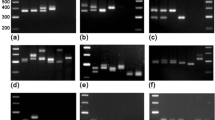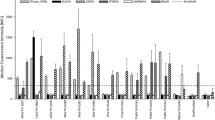Abstract
Two forms of barley net blotch are caused by different formae of the fungus Pyrenophora teres and both are economically important pathogens. The spot form of the net blotch fungus (P. teres f. maculata) and the net form of the net blotch fungus (P. teres f. teres) cause the lesion types indicated by their disease names, although symptom overlap and similar spore morphology can make identification difficult. Randomly amplified polymorphic DNA fragments differentiated the two forms of Pyrenophora. Polymorphic bands were cloned and sequenced to develop specific primer sets. A simple assay based on the polymerase chain reaction was developed and can identify the Pyrenophora formae causing disease symptoms directly from infected plant tissues in a single multiplex reaction. The assay was validated using amplified fragment length polymorphism genotyping of isolates and was shown to be more accurate than reliance on symptom expression. This assay can now be used for routine diagnosis, epidemiological studies and resistance breeding, where correct identification of each pathogen is critical.
Similar content being viewed by others
References
Bulat SA, Mironenko NV (1990) Species identity of the phytopathogenic fungi Pyrenophora teres Drechsler and P. graminea Ito et Kuribayashi. Mikologija Fitopatologija 24, 435–441.
Crous PW, Janse BJH, Tunbridge J, Holz G (1995) DNA homology between Pyrenophora japonica and P. teres. Mycological Research 99, 1098–1102.
Ho KM, Tekauz A, Choo TM, Martin RA (1996) Genetic studies on net blotch resistance in a barley cross. Canadian Journal of Plant Science 76, 715–719.
Ito S, Kuribayashi K (1931) The ascigerous forms of some graminicolous species of Helminthosporium in Japan. Journal of the Faculty of Agriculture Hokkaido University 29, 85–125.
Khan TN (1987) Relationship between net blotch (Drechslera teres) and losses in grain yield of barley in Western Australia. Australian Journal of Agricultural Research 38, 671–679.
Khan TN (1989) Effect of spot type net blotch (Drechslera teres (Sacc.) Shoem) infection on barley yield in short season environment of northern cereal belt of Western Australia. Australian Journal of Agricultural Research 40, 745–752.
Langridge P, Karakousis A, Nield J (1998) ‘Practical workshop in basic recombinant DNA techniques.’ (Special Research Centre for Basic and Applied Plant Molecular Biology: Adelaide)
Louw JPJ, Victor D, Crous PW, Holz G, Janse BJH (1995) Characterisation of Pyrenophora isolates associated with spot and net type lesions on barley in South Africa. Journal of Phytopathology 143, 129–134.
Makela K (1972) Leaf spot fungi of barley in Finland. Suomen Maataloustieteellisen Seuran Julkaisuja 124, 3, Acta Agrologica Fennica Helsinki 22 pp.
McDonald WC (1967) Variability and the inheritance of morphological mutants of Pyrenophora teres. Phytopathology 57, 747–755.
Nei M, Li WH (1979) Mathematical model for studying genetic variation in terms of restriction endonucleases. Proceedings of the National Academy of Sciences USA 76, 5269–5273.
Nirenberg H (1995) Morphological differentiation of Fusarium sambucinum Fuckel sensu stricto, F. torulosum (Berk. and Curt.) Nirenberg com. nov. and F. venenatum Nirenberg sp. nov. Mycopathologia 129, 131–141.
Peever TL, Milgroom MG (1994) Genetic structure of Pyrenophora teres populations determined with random amplified polymorphic DNA markers. Canadian Journal of Botany 72, 915–923.
Peltonen S, Jalli M, Kammiovirta K, Karjalainen R (1996) Genetic variation in Drechslera teres populations as indicated by RAPD markers. Annals of Applied Biology 128, 465–477.
Raeder U, Broda P (1985) Rapid preparation of DNA from filamentous fungi. Letters in Applied Microbiology 1, 17–20.
Reeves JC, Ball SFL (1991) Preliminary results on the identification of Pyrenophora species using DNA polymorphisms amplified from arbitary primers. Plant Varieties and Seeds 4, 185–189.
Rogowsky PM, Guidet FLY, Langridge P, Shepherd KW, Koebner RMD (1991) Isolation and characterization of wheat-rye recombinants involving chromosome arm 1DS of wheat. Theoretical and Applied Genetics 82, 537–544.
Rozen S, Skaletsky HJ (1998) Primer3. Code available at http:// www.genome.wi.mit.edu/genome_software/other/primer3.html
Schilling AG, Moller EM, Geiger HH (1996) Polymerase chain reaction-based assays for species-specific detection of Fusarium culmorum, F. graminearum, and F. avenaceum. Phytopathology 86, 515–522.
Scott DB (1991) Identity of Pyrenophora isolates causing net-type and spot-type lesions on barley. Mycopathologia 116, 29–35.
Sivanesan A (1987) Graminicolous species of Bipolaris, Curvularia, Drechslera, Exserohilum and their teleomorphs. Mycological Papers 158, 1–261.
Smedegård-Petersen V (1971) Pyrenophora teres f. maculata f. nov and Pyrenophora teres f. teres on barley in Denmark. Aarsskrift Kongelige Veterinaer og Landbohojskole. 1971, 124–144.
Speakman JB, Pommer EH (1986) A simple method for producing large volumes of Pyrenophora teres spore suspension. Bulletin of the British Mycological Society 20, 129.
Swofford DL (2000) PAUP*. Phylogenetic Analysis Using Parsimony (*and Other Methods). Version 4. Sinauer Associates, Sunderland, Massachusetts
Tekauz A (1990) Characterisation and distribution of pathogenic variation in Pyrenophora teres f. teres and P. teres f. maculata from Western Canada. Canadian Journal of Plant Patholgy 12, 141–148.
Vos P, Hogers R, Bleeker M, Reijans M, van de Lee T, Hornes M, Frijters A, Pot J, Peleman J, Kuiper M, Zabeau M (1995) AFLP: a new technique for DNA fingerprinting. Nucleic Acids Research 23, 4407–4414.
Wallwork H, Lichon A, Sivanesan A, (1992) Pyrenophora hordei — a new ascomycete with Drechslera anamorph affecting barley in Australia. Mycological Research 96, 1068–1070.
Williams JGK, Kubelik AR, Livak KJ, Rafalski JA, Tingey SV (1990) DNA polymorphisms amplified by arbitrary primers are useful genetic markers. Nucleic Acids Research 18, 6531–6535.
Willits DA, Sherwood JE (1999) Polymerase chain reaction detection of Ustilago hordei in leaves of susceptible and resistant barley varieties. Phytopathology 89, 212–217.
Yoder WT, Christianson LM (1998) Species-specific primers resolve members of Fusarium section Fusarium. Fungal Genetics and Biology 23, 68–80.
Author information
Authors and Affiliations
Corresponding author
Rights and permissions
About this article
Cite this article
Williams, K.J., Smyl, C., Lichon, A. et al. Development and use of an assay based on the polymerase chain reaction that differentiates the pathogens causing spot form and net form of net blotch of barley. Australasian Plant Pathology 30, 37–44 (2001). https://doi.org/10.1071/AP00063
Received:
Accepted:
Published:
Issue Date:
DOI: https://doi.org/10.1071/AP00063




